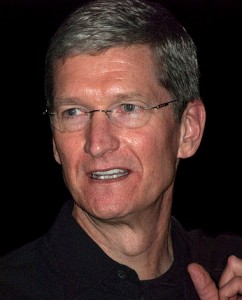The case of Apple Inc.’s (NASDAQ:AAPL) iPhone 5C, which has generated miserable sales compared to its glamorous sibling, the iPhone 5S, raises the question of whether Tim Cook is losing the keen grasp of what his customers want that helped Steve Jobs secure ongoing sales in an earlier era. Following the iPhone 5C’s lackluster performance, Mr. Cook’s remarks placed the blame on the smartphone’s lack of the Touch ID fingerprint scanner found on the 5S.
That the iPhone 5C failed to live up to the sales expectations that Apple (AAPL) executives had for it is proven by even a casual glance at the statistics. A report created by Mixpanel shows that the lower-end smartphone captured a meager 6 percent of the market, compared to the 20 percent or more devoured by the far more expensive 5S. From such figures, it is clear that Apple’s attempt to penetrate the cheap smartphone market currently dominated by Samsung, LG, and other competitors failed dismally.
 Though a minority of iPhone 5C sales were lost due to the lack of the Touch ID fingerprint scanner – people are, after all, fascinated by gadgets and new features – Mr. Cook’s claim that this was the central reason for the smartphone’s failure seems misguided and uncharacteristically opaque. On the practical front, many sales are coming from the so-called BRIC countries (Brazil, Russia, India, China), where smartphone markets are not yet saturated. Yet in these markets, the 5C is an undesirable hybrid of traits, “neither fish nor flesh,” as the old phrase goes.
Though a minority of iPhone 5C sales were lost due to the lack of the Touch ID fingerprint scanner – people are, after all, fascinated by gadgets and new features – Mr. Cook’s claim that this was the central reason for the smartphone’s failure seems misguided and uncharacteristically opaque. On the practical front, many sales are coming from the so-called BRIC countries (Brazil, Russia, India, China), where smartphone markets are not yet saturated. Yet in these markets, the 5C is an undesirable hybrid of traits, “neither fish nor flesh,” as the old phrase goes.
The 5C may be cheap by American standards, but it is still very expensive to a low to middle income individual in the BRIC countries looking for a cheap smartphone. It lacks the features and quality of the 5S, yet is priced out of reach of lower income consumers anyway. Those who are able to afford the 5C can also afford the 5S, and naturally prefer it. Even in India, 5S sales outnumber those of iPhone 5Cs by 2-to-1. In affluent countries like the United States, the ratio rises to 3.4-to-1.
Even more critically, though, is that the 5C is an esthetic failure. A good part of Apple Inc.’s (AAPL) market power, it could be argued, derives from the sleek, crisp, shimmering artistry of its products. Silvers, whites, and abundant glass give the typical Apple device an ultramodern look, which is accompanied by equally pleasing tactile qualities. The 5C, however, has a polycarbonate body which feels far less smooth and high-quality than the metal body on other iPhones. Worse still, its bright, bubblegum case colors offend the sensibilities of Apple aficionados, resembling, according to one pithy, savage criticism, “Technicolor vomit.”
Tim Cook’s failure to recognize the true causes of the iPhone 5C’s failure – in particular, the esthetic gaffes of the overly-colorful, cheap-feeling telephone, and its unappealing price point – does not bode well for future design decisions while he is at the helm. It might be wondered if he lost track of the pulse of Apple Inc.’s (AAPL) most loyal customers, and whether additional garish, cheap-seeming products are possible. Steve Jobs and Jony Ive built the Cupertino enterprise’s fortunes on a highly distinctive sense of taste, finesse, and style. Mr. Cook would be well advised not to try to fix what is not broken, and concentrate on taking Apple’s strengths in new directions, rather than disregarding them entirely.



